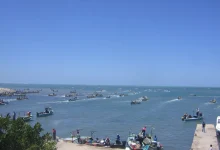The Strait of Hormuz is one of the world’s most strategically important maritime chokepoints. Located between the Persian Gulf and the Gulf of Oman, it serves as a vital conduit for global oil transportation. The strait is bordered by Iran to the north and Oman to the south, specifically the Musandam Peninsula, which is an exclave of Oman.
Geographical and Physical Features
The Strait of Hormuz is approximately 33 kilometers (21 miles) wide at its narrowest point, with shipping lanes that are about 3 kilometers (2 miles) wide in each direction, separated by a 3-kilometer-wide buffer zone. The depth of the strait varies, but it is generally shallow, with an average depth of about 30 meters (98 feet), though some areas are deeper. This relatively shallow depth can be a challenge for large oil tankers, necessitating careful navigation.
Strategic Importance
The strategic importance of the Strait of Hormuz cannot be overstated. It is a critical artery for the global oil trade, with about one-fifth of the world’s petroleum passing through it. This includes oil from major producers like Saudi Arabia, Iran, Iraq, Kuwait, the United Arab Emirates, and Qatar. The strait also facilitates the transportation of liquefied natural gas (LNG), particularly from Qatar, which is one of the world’s leading LNG exporters.
The heavy reliance on this narrow passageway makes it a focal point of geopolitical tensions. Any disruption in the flow of oil and gas through the Strait of Hormuz can have significant implications for global energy prices and supply stability. Historically, there have been several incidents and conflicts that underscored its vulnerability, including the Iran-Iraq War in the 1980s, where both countries targeted oil tankers in the so-called “Tanker War.”
Historical Context
The Strait of Hormuz has a rich history, with its significance dating back to ancient times. It has been a vital maritime route for centuries, used by traders and explorers from various civilizations. The strategic importance of the strait was recognized by the Portuguese in the early 16th century, who established a fort on the island of Hormuz to control the trade routes.
Throughout history, the control and security of the Strait of Hormuz have been of paramount importance to regional and global powers. In the 20th century, with the discovery of vast oil reserves in the Persian Gulf, the strait’s significance increased exponentially.
Modern Geopolitical Significance
In contemporary times, the Strait of Hormuz remains a flashpoint in international relations. The United States, along with its allies, has a vested interest in ensuring the free flow of oil through the strait. To this end, the U.S. Navy maintains a significant presence in the region, often conducting freedom of navigation operations to assert international rights of passage.
Iran, on the other hand, views the strait as a lever of influence in its relations with the West. At various times, Iranian officials have threatened to close the strait in response to international sanctions or military threats. Such threats have typically been met with strong responses from the global community, emphasizing the potential for conflict in the region.
Economic Impact
The economic implications of the Strait of Hormuz are profound. Given that a significant portion of the world’s oil supply transits through this narrow passage, any disruption can lead to substantial fluctuations in global oil prices. The strait’s importance is further magnified by the fact that many of the world’s largest oil producers rely on it to export their products.
Countries around the world, particularly those heavily dependent on oil imports, keep a close watch on the security and stability of the Strait of Hormuz. The Organization of the Petroleum Exporting Countries (OPEC) and other major oil-producing nations also have a keen interest in the strait, as its security directly affects their economies.
Environmental Concerns
The Strait of Hormuz is not only an economic and strategic asset but also an area of environmental concern. The dense traffic of oil tankers and other vessels increases the risk of oil spills, which can have devastating effects on the marine ecosystem. The region is home to diverse marine life, including coral reefs, fish species, and marine mammals, all of which could be severely impacted by pollution.
International regulations and conventions aim to mitigate these risks, but the potential for environmental disasters remains a significant concern. Efforts are continuously made to enhance safety and environmental protection measures in the strait.
Future Prospects
Looking ahead, the importance of the Strait of Hormuz is unlikely to diminish. As global energy demand continues to rise, the strait will remain a crucial conduit for oil and gas transportation. However, the future is also fraught with uncertainties. Technological advancements, such as the development of alternative energy sources and new shipping routes, could alter the dynamics of global energy trade.
Moreover, regional geopolitical developments will continue to shape the strait’s significance. The ongoing tensions between Iran and its neighbors, as well as with Western powers, suggest that the Strait of Hormuz will remain a focal point of international security concerns.
In conclusion, the Strait of Hormuz is a vital geographic feature with far-reaching implications for global trade, energy security, and international relations. Its strategic importance, historical context, and economic impact underscore its role as one of the most critical waterways in the world. The challenges and opportunities associated with the strait will continue to influence global geopolitics and economics for the foreseeable future.

